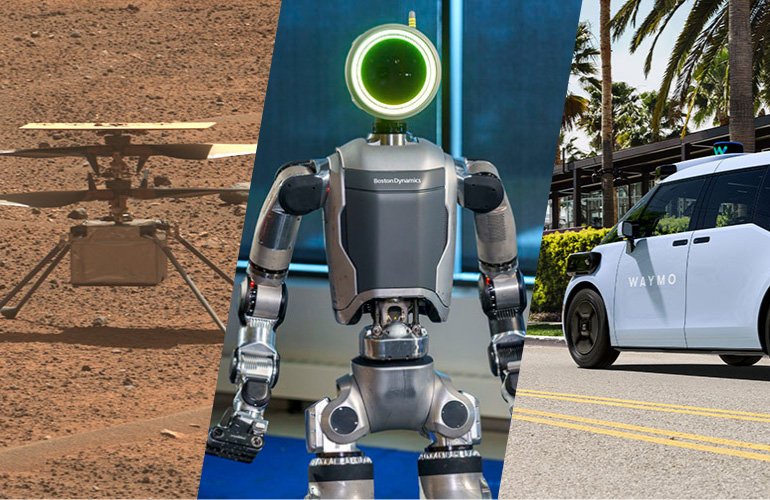
With 2024 in the rearview mirror, we’re looking back at some of the biggest robotics trends of the year. While the year was full of exciting innovations and new technologies, we also saw the industry weather dips in funding and slower sales. Here are our five biggest trends for 2024:
Humanoids continue to dominate the news
The biggest story in 2024, by far, was all of the humanoid robots. But this year wasn’t just about flashy headlines, it was also about real, tangible advancements for the technology.
Agility Robotics’ Digit remains a leader in the space. In June, we learned that GXO officially deployed a “small fleet” of Digit humanoids at a Spanx facility in Georgia.
In November, Schaeffler AG made a minority investment into Agility and planned to buy Digit robots for use across its global plant network. These marked the first paying deployments for humanoid robots.
Figure AI is also shipping its Figure 02 system to its first paying customers. While we don’t know who its first customer is, the company said BMW Group had tested Figure 02 for handling fitted sheet-metal parts on its automotive production line for two weeks in Spartanburg, S.C. The company closed its Series B round of $675 million in February, marking one of the biggest funding rounds of the year.
We also saw a slew of new humanoid robot releases this year. Most notably, Boston Dynamics released an electric version of its Atlas robot. Atlas had long drawn attention with its impressive capabilities but remained just a research project due to its hydraulic actuation design.
The new electric Atlas is the company’s first step into the commercial humanoid race. So far, Boston Dynamics has shown the robot doing pushups and handling large automotive parts.
Other humanoid releases include EngineAI’s PM01, Pudu Robotics’ PUDU D9, 1X’s NEO Beta, LimX’s updated CL-1, Figure 02, Unitree Robotics’ G1, Sanctuary AI’s upgraded Phoenix, Mentee Robotics’ Menteebot prototype, and more.
In addition, we’ve seen many advances with Tesla’s Optimus robot throughout the year. Optimus is perhaps the most high-profile humanoid robot and this year, it grabbed attention by mixing drinks and mingling at Tesla’s We, Robot event in October.
Later, Bloomberg, The Verge, and other outlets reported the robots were being remotely operated by humans, not acting autonomously.
Foundation models gain traction
Advances in artificial intelligence, particularly foundation models, have been gaining traction in the robotics industry this year, with both established companies and new startups investing in the technology. NVIDIA announced Project GR00T, a research initiative that’s developing general-purpose foundation models, tools, and technologies for accelerating humanoid robot development, at GTC 2024.
NVIDIA said it designed this new model to enable robots to understand natural language and emulate movements by observing human actions.
In July, Skild AI emerged from stealth mode and closed a $300 million Series A round. The company is developing the Skild Brain, a robotics foundation model, as well as a mobile manipulation platform and a quadruped platform for security and inspection.
Later, Physical Intelligence raised $400 million to continue its development of AI for a range of robots. The company said its generalist policy will make robots easier to program and use. Its early demonstrations included robots folding laundry, assembling boxes, and dynamically putting objects into containers.
Amazon also further invested in developing foundation models. It hired Covariant’s founders and around 25% of its staff and signed a non-exclusive license to use the company’s robotic foundation models.
The company described its Covariant Brain as a “universal AI platform.” Amazon has launched the Amazon AGI SF Lab to develop new foundational capabilities for enabling useful AI in the digital and physical worlds.
Robot sales slow in North America in 2024
While we don’t yet have robotics sales statistics for all of 2024, the first three quarters of the year were not encouraging. From January through September 2024, North American businesses ordered 23,034 robots valued at $1.4 billion, a 1.9% decline in units and a 2.2% drop in revenue in comparison with the same period in 2023, according to the Association for Advancing Automation (A3). Robot orders had already dropped 30% in 2023 from 2022.
In particular, sales declined 32% in semiconductors, electronics, and photonics, and they declined 21% in automotive components. A3 attributed these slowing sales to tight capital budgets, high interest rates, and slowed industrial output, particularly in electric vehicles.
While these numbers don’t look great, the news wasn’t all bad. For one, A3 only tracks industrial robot sales, which doesn’t include things like autonomous mobile robots (AMRs) or collaborative robots. So, these numbers could also indicate a shift away from industrial robots and towards more flexible forms of automation.
Additionally, while sales declined in sectors that traditionally adopt many robots, they’ve grown in other areas. Orders increased in food and consumer goods (+60%); life sciences, pharmaceuticals, and biomedical (+43%); and metals (+8%).
Content retrieved from: https://www.therobotreport.com/the-5-biggest-robotics-trends-of-2024/.






